De Courcy Lewthwaite Dewar
De Courcy Lewthwaite Dewar (12 February 1878 – 24 November 1959) was a decorative metalwork designer, and member of the Glasgow Girls group of artists during the 1890/1900s.[1]
De Courcy Lewthwaite Dewar | |
|---|---|
| Born | 12 February 1878 Kandy, Sri Lanka |
| Died | 24 November 1959 |
| Education | Glasgow School of Art |
| Known for | Decorative Metalwork |
| Style | Glasgow Style |
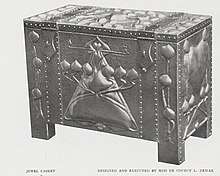
Early life
Dewar was born on 12 February 1878 in Kandy, Sri Lanka, which was then known as British Ceylon. Her father was a tea planter called John Lewthwaite Dewar and her mother was Amelia Cochrane. Her unusual first name is a family name, although she was also known by the pet name of Kooroovi, meaning small bird in Tamil.[2]
Career
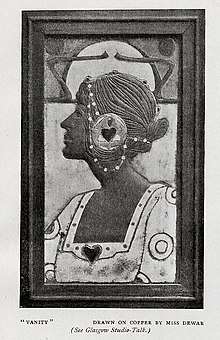
Dewar studied enamel and metalwork at Glasgow School of Art from 1891 until 1908 or 1909[3]. She was taught metalwork by Peter Wylie Davidson. Her work was often illustrated in The Studio magazine. For thirty-eight years, De Courcy taught at Glasgow School of Art, being appointed instructor of enamels by Fra Newbery. She worked alongside fellow artists Ann Macbeth, Jessie M. King, Dorothy Carleton Smyth, Jean Delville, Peter Wylie Davidson, and Kellock Brown. She instituted the Dewar Prize for enamels to be awarded at the Annual Exhibition of the Glasgow School of Art Club[4]. She had a studio at Central Chamber, 93 Hope Street, Glasgow, where she worked independently from 1900 - 1926. After 1926, she continued to work in a studio at her home at 15 Woodside Terrace, Glasgow[3]
Some of her decorative metalwork pieces were used for illustration in Applied Design in Precious Metals, a publication by her colleague Peter Wylie Davidson.[5]. Her enamel work was exhibited at the Scottish Section of the Prima Esposizione Internazionale d'Arte Decorativa Moderna in Turin in 1902[6].
Dewar was involved with the women's suffrage movement. She designed a banner in 1911 for use at the coronation of George V in London for a fee of 30 shillings. This banner, stating 'Let Glasgow Flourish' is now held at the Glasgow Museums Resource Centre in Glasgow.[7][8]
Dewar and her sister ran a house for destitute women in the Bellshill area called Harkness House, which the Prince of Wales visited in the 1930s.[9]
She wrote the History of the Glasgow Society of Lady Artists' Club, published in 1950.[10] While writing this she was the President of the Glasgow Society of Lady Artists, now known as the Glasgow Society of Women Artists.[2]
De Courcy lived with her sister, Katharine, at 15 Woodside Terrace, Glasgow, until her death.
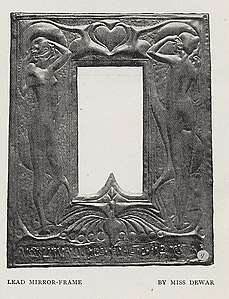 Image published in The Studio vol 15 (1899)
Image published in The Studio vol 15 (1899)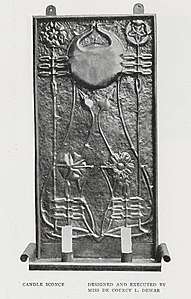 Image published in The Studio vol 19 (1900)
Image published in The Studio vol 19 (1900) Image published in The Studio vol 42 (1908)
Image published in The Studio vol 42 (1908) Image published in The Studio vol 47 (1909)
Image published in The Studio vol 47 (1909)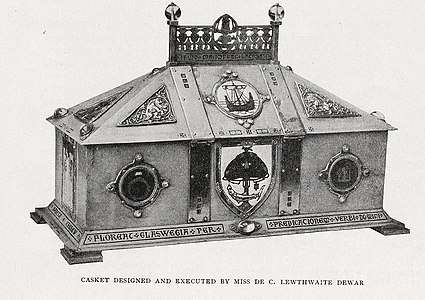 Image published in The Studio vol 66 (1915)
Image published in The Studio vol 66 (1915)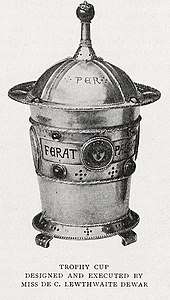 Image published in The Studio
Image published in The Studio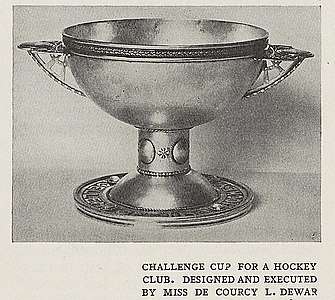 Image published in The Studio vol 86 (1923)
Image published in The Studio vol 86 (1923)
References
- "Glasgow Society of Women Artists - we love art!". Glasgow Society of Women Artists - we love art!. Retrieved 17 May 2018.
- "Dewar, De Courcy Lewthwaite (1878-1959) | GSA Archives". www.gsaarchives.net. Retrieved 17 May 2018.
- Burkhauser, Jude (1990). Glasgow Girls: Women in Art and Design 1880 - 1920.
- "de Courcy Lewthwaite Dewar". Glasgow Museums. Retrieved 8 December 2018.
- Davidson, Peter Wylie (1929). Applied design in the precious metals: An educational work in which tool-form and material are utilised in the development of design. British Library: Longmans.
- "The Studio" (vol 26). 1902.
- Crawfurd, Elizabeth (2003). The Women's Suffrage Movement: A Reference Guide 1866-1928. Routledge.
- "Glasgow Museums Collections Online". Collections Navigator. Retrieved 8 December 2018.
- "Full record for 'MISS DE COURCEY DEWAR' (1512) - Moving Image Archive catalogue". movingimage.nls.uk. Retrieved 17 May 2018.
- (GLASGOW), Glasgow Society of Lady Artists' Club (1950). "History of the Glasgow Society of Lady Artists' Club". www.theeuropeanlibrary.org. Retrieved 17 May 2018.